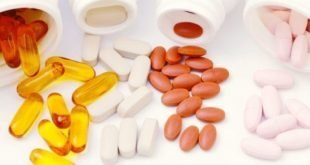 Calcium is very important for the body.
Calcium is very important for the body.
In the human body contains from 1 to 2.2 kg of calcium. It is well known that this mineral is the basis of bone tissue. However, its functional role in human biology is much broader: calcium normalizes the metabolism of water, sodium chloride, carbohydrates; the processes involved in the transmission of neuromuscular excitation; regulates the clotting of blood; influences the permeability of cell membranes, reduces the permeability of vascular walls, activates some enzymes; affects acid-alkaline balance of the body.
If the person loses calcium from the diet, the body begins to compensate for the lack of this substance on their own.
As an external source of calcium or no calcium intake is not digested completely, the body “steals” calcium from the skeleton. First and foremost, this mineral is flushed out of the jaws (which leads to periodontitis and subsequently to the loss of teeth), later the problem starts with the spine, bones, limbs, etc. This scientific fact, incidentally, explains the village saying that a woman pays with a tooth for each child, writes Eugene Sutyagin in the book “the Bible of healthy eating. Simple rules that will allow you to eat right and stay healthy and slim”.
As the calcium is embedded in the bone tissue
While circulating through the vessels, blood transportorul a variety of chemical substances, one of which is a compound of manganese and calcium. In order for a molecule of this compound was in a cage of bone, the necessary “key” – this key is the vitamin D receptor (these substances are a group of fat-soluble secosteroids, they are responsible for enhancing intestinal absorption of calcium and phosphate).
In addition, the bone cannot absorb calcium-manganese compound without the participation of vitamin K, and boron, potassium, magnesium, copper, phosphorus, zinc and omega-3 acids.
This scheme may seem complex, but the well-organized, balanced diet provides the body with all the components necessary for saturation of bone calcium.
Verify that the problem often is not lack of calcium in the diet (for example, 2 liters of water contains daily value of this mineral), namely in the inability of the body to fully utilize the functionality of this item.
The causes of destruction of bone tissue
The main factor that calcium is not absorbed properly and thus not able to functionally enrich and strengthen bone tissue, is the destruction of the vitamin D receptor and parathyroid hormone (secondary thyroid hormone) as a result of increased level of glucose in the blood.
Even when a sufficient amount of incoming calcium malfunction of the receptor of vitamin D does not allow calcium to integrate into the bone tissue. Thus, elevated levels of sugar in the blood leads to the destruction of bone tissue.
The reason for the fail to cope with calcium may be a violation of digestion in the gastrointestinal tract.
Another factor in the forced-participation of calcium in building bone tissue – deficiency in the diet fatty acids omega-3, which are also required for the proper functioning of the mechanism of calcium absorption.
How to avoid the destruction of bone tissue
Functional nutrition, we’re talking about in this book is aimed, in particular, on the normalization occurring in the body’s metabolic processes. Proper metabolism helps to avoid increasing glucose levels in the blood, which, as we have seen, is the main reason “rejection” of calcium in bone.
The diet should be:
– fractional: 4-5 meals a day, serving not more than 200-250 g;
– balanced:
proteins: 100 grams of beef liver or any seafood 4 times a day (at a time the pancreas is able to allocate such amount of enzyme, which is enough for splitting only 10 grams of protein pure protein);
fats: a teaspoon of unrefined Flaxseed oil at one time (not more than 30 g per day);
– carbohydrates: not more than 50 g of carbohydrate (rice, potatoes, bread) for the reception at the four nutrition – daily consumption of carbohydrates should not exceed 6 conditional teaspoons of sugar (for example, 70 g rye bread is converted into the body 20 grams of sugar); instead of a carbohydrate side dishes or bread during the day you can eat 70 g of bananas or apples, or 300 ml of soup, or 200 ml rice soup with potatoes.
Products, providing the body needed for bone tissue strengthening substances
Green tea contains catechins, which prevent the destruction of bone tissue by osteoclasts (cells that dissolve the mineral component of bones and Deplete collagen is one of the main proteins, which form bone, skin and connective tissue). Daily dose – 1-2 cups. Drinking green tea is best for half an hour before meals or half an hour after a meal.
Many fruits and berries are rich in potassium, which is necessary for calcium absorption. We recommend you to use 70-100 g of fruit and berries for 10 minutes before eating 4 times a day.
Purple products (star anise, cloves, cinnamon, red and black pepper, juniper berries) are rich in manganese. Daily dose of manganese contains, for example, 15 dry clove flower buds. Keep in mind that during heat treatment, the manganese loses its properties.
Rice husk, lentil sprouts, raw green buckwheat, dry oats, bran is a good source of magnesium. You should use them with roasted vegetables or add to soup 10 g twice a day.
100 g of beef liver contains half the daily requirement of magnesium. Steaming retains up to 50% of this element.
Oysters are rich in zinc. To get a daily dose of zinc you need to eat six clams per day. Sources of zinc may also serve other seafood.
Cheese is wonderful in that it contains calcium and phosphorus in the ideal for the formation of bone tissue ratio. 100 g of this product contains a quarter of the daily requirement of phosphorus.
Only two raw quail egg yolks contain the required amount of vitamin D that will ensure thyroid all needed to produce all the same hormones and vitamins. They need to be consumed raw it is safe, as quail eggs are not infected by Salmonella.
Sea fish (salmon, herring, mackerel, etc.), on the one hand, rich in selenium, which activates thyroid hormone, on the other hand, is a source of hormone D (household name for vitamin D) and vitamin E, fatty acids omega-3 and copper, phosphorus and zinc.
Cod is the source of the amino acid tyrosine, which is involved in the synthesis of thyroid hormones.
Wild and cultivated greens and vegetables: broccoli, nettle, dandelion (leaf), parsley, dill, spinach, etc contain vitamin K (for this discovery in 1943 was awarded the Nobel prize in physiology or medicine). Vitamin K binds calcium with the bone tissue, strengthening it, and increases blood clotting.
Actually calcium is well absorbed from cooked or raw vegetables, greens.
Food combining for healthy bones
Beef liver with turnips and prunes. The liver is rich in copper, which plays an important role in the formation of elastin and collagen. Fresh turnips and prunes put into the body of boron, deficiency of which inhibits the formation of osteoblasts – cells that form bone tissue (in contrast to osteoclasts).
Raw quail yolk with sprouted lentils and greens. Vitamin D in the yolk is essential for the absorption of calcium, a large number of which is contained in greens and lentil sprouts are rich in magnesium, which is also involved in the formation of bone tissue. It is not necessary to consume these products simultaneously.
Salted far Eastern salmon and Kale. The principle of shared work products are the same: vitamin D from fish, helps in better absorption of calcium from Kale, from the gastrointestinal tract. In addition, these products are valuable for bone tissue themselves.
Nettle with linseed oil and walnuts, 100 g of nettle – half of the daily requirement of calcium, which is absorbed in the part contained in the nuts of trace elements (zinc, copper, iodine, magnesium, phosphorus, cobalt). Nettle (leaves) – excellent source of vitamin K, which can not be fully absorbed without fats (flax seed oil).
Foods that can harm bone
– Caffeine containing beverages (mainly coffee and tea): caffeine inhibits the absorption of calcium and promotes its secretion by the kidneys.
– Uncontrolled intake per serving of wheat bran and dairy products rich in phosphorus prevents the absorption of calcium.
– Peanut butter.
– Excessive amount of at one meal of protein
increases calcium excretion in the urine, while animal protein causes greater calcium loss than vegetable.
– Foods rich in sodium.
– Processed cheese, including chocolate.
Sauces based on vegetable oils, mayonnaise and tucked them difficult salads.
– Sweet drinks.
– Wheat bread, pasta.
– Cakes and pastries with cream.
Ice cream.
– Cornflakes, toast, chips.
– Alcoholic beverages.
For more tips
– As often as possible eat fresh low-calorie foods such as broccoli, cabbage and cauliflower, green onions, cucumbers, parsley, rhubarb, radishes, lettuce, tomatoes, dill, spinach, and lentil sprouts and wheat.
– Vitamin D does not tolerate heat treatment, even steaming. So, if you want to get this vitamin with fish, she should be fresh or salted.
– Food should enter the mouth slowly and perezhevyvaya carefully and without haste.
Physical exercise can help strengthen bones, help them seal and prevent the loss of calcium.
© 2017 – 2019, paradox. All rights reserved.





